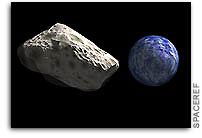Identifying Near Earth Object Families

http://images.spaceref.com/news/neo.earth.jpg
Astrophysics, abstract
astro-ph/0505270
From: Hai Fu [view email]
Date: Thu, 12 May 2005 23:11:58 GMT (459kb)
Identifying Near Earth Object Families
Authors:
Hai Fu,
Robert Jedicke,
Daniel D. Durda,
Ronald Fevig,
James V. Scotti
Comments: Accepted for publication in Icarus. 19 pages including 11 figures
The study of asteroid families has provided tremendous insight into the
forces that sculpted the main belt and continue to drive the collisional and
dynamical evolution of asteroids. The identification of asteroid families
within the NEO population could provide a similar boon to studies of their
formation and interiors. In this study we examine the purported identification
of NEO families by Drummond (2000) and conclude that it is unlikely that they
are anything more than random fluctuations in the distribution of NEO
osculating orbital elements. We arrive at this conclusion after examining the
expected formation rate of NEO families, the identification of NEO groups in
synthetic populations that contain no genetically related NEOs, the orbital
evolution of the largest association identified by Drummond (2000), and the
decoherence of synthetic NEO families intended to reproduce the observed
members of the same association. These studies allowed us to identify a new
criterion that can be used to select real NEO families for further study in
future analyses, based on the ratio of the number of pairs and the size of
strings to the number of objects in an identified association.
Full-text: PostScript, PDF, or Other formats
References and citations for this submission:
SLAC-SPIRES HEP (refers to ,
cited by, arXiv reformatted);
CiteBase (autonomous citation navigation and analysis)
Which authors of this paper are endorsers?








